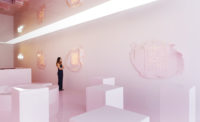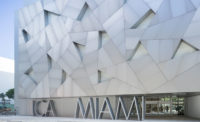Just Connect at Design Miami 2016

Flotsam & Jetsam, a pair of 3-D printed pavilions created by SHoP Architects, sat outside the entrance to Design Miami.
Photo © Robin Hill

Robots built the jellyfish-like structures, which were set among toys on a small beach.
Photo © Robin Hill

Büro Ole Scheeren’s Stage encouraged server–customer interaction.
Photo courtesy Dean & Deluca; © James Harris

Büro Ole Scheeren’s Stage encouraged server–customer interaction.
Photo courtesy Dean & Deluca; © James Harris

Pedro&Juana’s Sobremesa invited guests into a specially designed courtyard where they could partake of free food and drink at communal tables.
Photo courtesy Dean & Deluca; © James Harris

Pedro&Juana’s Sobremesa invited guests into a specially designed courtyard where they could partake of free food and drink at communal tables.
Photo courtesy Dean & Deluca; © James Harris

Tabanlioğlu Architects made the Flamingo Lounge one color and material—pink resin—to give VIP collectors a respite from the fair’s bustle.
Photo © James Harris

Tabanlioğlu Architects made the Flamingo Lounge one color and material—pink resin—to give VIP collectors a respite from the fair’s bustle.
Photo © James Harris

Atelier Biagetti designed NO SEX in Miami to encourage discussion about what is alluring nowadays.
Photo © James Harris









Architects at the latest edition of Design Miami, which ran from November 30 to December 4 in the city’s Design District, were all about getting up close and personal, creating spaces where 40,000 fairgoers could interact with—or react to—one another.
These exchanges began even before visitors entered the exhibition. By the doorway, New York–based SHoP Architects, winner of the 2016 Panerai Visionary Award for innovative fabrication and delivery techniques, constructed a public plaza anchored by two 13-foot-tall pavilions. Called Flotsam & Jetsam, the structures resembled jellyfish…and were fabricated by robots from 47 miles of carbon-fiber-reinforced plastic. The impetus was both artistic and practical. “We want to make a mesh strong enough—and we hope eventually cheap enough—to replace a stud wall,” explained Philip Nobel, SHoP’s editorial director. Added SHoP principal Greg Pasquerelli: “There’s something magical about making a pavilion that is technological and beautiful but took only five months from start to finish.” (Postfair, Flotsam & Jetsam moved to the city’s Jungle Plaza, where it will serve as a cultural event space for the next two years.)
Inside the Design Miami tent, architects explored the relationship between hosts and guests. Berlin-based firm Büro Ole Scheeren unveiled Stage, a chef-led fast-food concept for gourmet grocer Dean & DeLuca. The freestanding food theater featured two polished stainless-steel rectangles, one floating above the other. The lower functioned as a wide countertop for a landscape of salads, deli meats, fruit, and bread, while the upper bestowed a bright halo effect on the food and servers. Scheeren designed Stage to encourage playful interaction between customers and food preparers. Judging from the crowd’s response, he succeeded.
Offering a different take on the concept, Pedro&Juana’s Sobremesa celebrated the Mexican tradition of lingering around the table after dinner. Working with sponsor Airbnb, the Mexico City–based architects Mecky Reuss and Ana Paula Ruiz Galindo created an indoor courtyard with perforated metal walls; there they mingled with fairgoers, inviting them to share in free snacks, cocktails, and conversation at communal tables.
For the fair’s VIP collectors, the Istanbul-based firm Tabanlioğlu Architects offered the pink resin–clad Flamingo Lounge. “Because Design Miami is so crowded and visually chaotic, we wanted to make the space one color and one type of material to isolate you from the fair,” said Tabanlioğlu spokeswoman Gonca Ark Caliska. She added that the choice of the pastel material reflected Miami and the nature of the firm’s practice, “which ranges from the colorful, surreal liquidity of Gaetano Pesce to the rigid utilitarian minimalism of Mies van der Rohe.”
Exhibitors also contributed to the wealth of installations. As part of the fair’s new Design Curio platform, six galleries presented experimental environments by cutting-edge designers. One booth, commissioned by the New York–based Patricia Findlay, offered a winking take on Miami’s Zika scare. Created by Milanese duo Atelier Biagetti, NO SEX in Miami pushed the boundary between desire and revulsion, presenting a surreal therapist’s office with a rubber-wrapped massage table, a floor lamp with a phallic bulb, and twin nurses in translucent pink lab coats. The idea, according to cofounder Alberto Biagetti, was to spur dialogue about what is and isn’t sexy. It was a spectacle that stopped foot traffic. It also forced fairgoers to engage with Biagetti and partner Laura Baldassari to grasp their intentions.
And ultimately that was the point. Such conversations are what made Design Miami even more compelling this year. By challenging familiar design narratives, the fair’s exhibitors prompted attendees to have a discussion with them—and with one another—about culture, technology, and craftsmanship.














